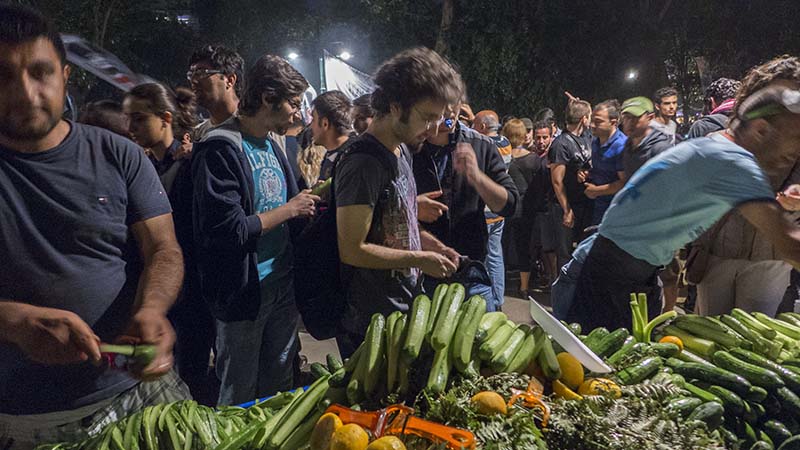He went to the war in Iraq and returned with love songs. Together we had often walked the back streets of Istanbul. ?You?ve come at the perfect time? he said Nilgun and Ozcan prepared the table for yet another home cooked meal. This was a stolen moment, in between Tokyo and Prague. A night halt to see my old friends and breathe the air of Taksim Square.

As always it was Ozcan I turned to, to make sense of the complex politics that surrounded Turkey. I knew of the trees and how the resistance grew from the small gathering to protect them to the massive collection we were witnessing.? But that didn?t explain it all. My thoughts wandered to Shahbag. To the clusters gathering on the night of February 5th. I had stopped my bicycle on the way back from Shilpakala Academy, where the closing events of Chobi Mela, our festival of photography was taking place. The torchlight processions had been spontaneous, the gatherings organic, but there was hope in the air.
Hope had also been what I had sensed years ago in Cairo, the week before Tahrir Square erupted.? Then too, I was soaking in the insight of streetwise photographers who sensed what was happening underneath it all. Gamal had told me we were sitting on a tinderbox ready to ignite. The following week, back in Dhaka, the shockwaves of that explosion reached us. I pored through the television footage, seeking out my students, by them in their struggle, but worried about their safety. As we sailed down the Rheine during the Global Media Forum in Bonn, Tarek Atia reaffirmed that much of the coverage had been done by my students. Meanwhile things were getting worse in Taksim Square. Cucumber sellers at Taksim Square had renamed their ware the ?Tayyip? and were doing brisk trade, but the prime minister upon return had taken a hard line. Social Media was evil, all protesters were foreign agents. I recognized the familiar response. In Bangladesh it had resulted in bloggers being jailed.
CNN footage showed a man being taken away in a police van. Thinning hair, ponytail. Only a back view. It could have been Ozcan. He responded to my hasty email, ?That is not me. I’m still free (!)? They had started the ?standing alone? campaign. ?This kind of resistance is good but always so fragile and open to provocations? he reminded me.
The ?Arab Spring? has become the catch all phrase the media has used as a peg to explain these disparate events, but what is it that ties it all together? The death of a fruit seller in angry protest against having been wronged, the ousting of a dictator who had morphed from being the war hero to the tyrant, and the distant cry to ensure no deals were made to pardon war criminals and now the campaign to save a few trees, seemed unconnected. Until one found the underlying thread that joined the dots.
These disparate events, scattered across the wider ?Muslim? states,? could only be understood if one walked these public gatherings, breathed the air, soaked in the euphoria. Through all the turmoil, it sang of hope. In Bangladesh, I had seen many more children. Parents wanting to engage them with events of over forty years ago, which had shaped their generation. Both in Shahbagh and in Taksim there were men women, mostly young, in traditional and modern garb. They chanted, sang songs. Volunteers brought in food. Medicine. Spontaneous help groups took care of those in need. This was camaraderie at its best. A people?s movement, separated from conventional party lines. In Bangladesh and Turkey, they protested against popular elected governments, In Egypt and Tunisia, the rulers had long overstayed their tenure. It was a movement for democracy, but not limited to elections. A protester in Taksim, carried a sign reminding us that Hitler too had been democratically elected.
The death of a fruit seller was of course important, but at a national level, especially in an autocratic regime, it wasn?t an issue that could topple a government. Trees being uprooted in the ?cause? of development was nothing new. Court rulings stage managed by government was something we were used to. So why his concerted outcry? Wherefrom this solidarity? What led to this outpouring of volunteerism where strangers were being cared for, fed, treated, because they were part of the movement.
Again it was Ozcan who made the connection. ?No one was listening, we were never consulted. We never had a say.? He spoke of an aspect of democracy that went beyond elections and popular votes. There was a need to be heard and the people were going to be listened to.
The right of the governed to have a say in the process of governance, was at the core of it all. People were going to have a say. Merely being in power, regardless of the mode of entry, never gave them the right to ride roughshod over the people?s will.
I breathed in the air, sang along with the songs. Danced in unison. Across the globe we were sending out a powerful message. We were going to be heard.
Shahidul Alam
Istanbul
Skip to content
Musings by Shahidul Alam
